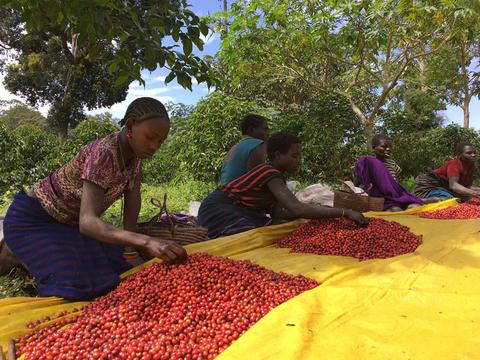
What are the flavor characteristics of coffee grown in different regions of the world? How can you recognize coffee grown in Guatemala and how it is different from the one grown in Kenya?
Although there are no universal rules or recommendations, coffee grown in different countries or regions is distinguished by its nuanced, well-known differences and aroma characteristics.
Due to a related ecosystem and climate, coffee matured in Guatemala will have an aroma similar to coffee from Honduran plantations. The similarity of coffee produced in these countries is also affected by the treatment.
Coffee growers in both countries process coffee beans by similar methods (wet process). In Indonesia and Kenya, mature coffee will come with a completely different aroma and qualities.
Below we will describe in general terms the aromas of coffee grown in different regions of the world, but it is worth noting that these trends continue until the coffee is processed and roasted. Many of the existing treatments affect the taste of coffee grown in any region.
Central America
Central America (excluding Belize) is a major supplier of the world coffee market.
Together with South Columbia, Central American countries hold a large share of the world market and dominate the American market for coffee, which, due to its convenient geographic location and the quality of the coffee produced, dictates the coffee culture and sets the most sought after flavors.
All Central American countries have similar climates and altitudes, planted coffee with related species, and coffee growers use similar processing techniques.
A common feature of growing coffee in this region is the nuanced acidity of the fruit. Guatemala’s coffee has a mild acidity of apples, while Mexico’s matured coffee has a cherry flavor.
Coffee produced in Central American countries shows signs of brown sugar sweetness, which passes into mild chocolate or puff pastry with a buttery aroma.
The aromas of fruits, mild coffee and herbs intertwine, with mild acidity. Coffee has almost the best-balanced aroma in this region.
South America
When it comes to coffee from South America, the first thought came from Colombia.
Coffee from the plantations distributed in this country enters the Top 3 of the largest coffee producers in the world.
The classic Colombian coffee, along with Peruvian premium coffee, is distinguished by its sweet acidity and strong caramel sweetness and has a peanut flavor.
It is these coffee aromas that place South America on the map of world coffee exports.
Brazil
In Brazil, matured coffee is worth highlighting among other South American countries. Firstly, because it is a major supplier of coffee to the world market and its products are widely distributed throughout the world.
Brazilian coffee beans, especially those labeled as “Brazil natural”, have a peanut flavor and a rich aroma. For this reason, they are most often used to make espresso coffee.
The chocolate and nuanced aroma of spices are the flags of Brazilian coffee. The coffee matured in the region is distinguished by its long-lasting aroma, unlike coffee from other South American countries.
Ethiopia
Once again, Ethiopia is worth highlighting as a separate category among the coffee exporting countries in its region. The first argument that gives Ethiopia exclusivity is the diversity of nature.
There are thousands of species of coffee trees growing in this country, many of them wild and not belonging to any of the strains. For this reason, there is ample opportunity to produce exclusive aromas, which are also used by Ethiopian coffee planters.
Ethiopia is characterized by a variety of coffee processing methods, both nationally and globally, as compared to other countries and coffee growers in the world.
The main types of coffee treatment: natural and moist. Using a natural treatment method, the coffee berry that protects the coffee beans is dried before the beans are removed.
When wet coffee is treated, within 12 hours of picking, the coffee berry is peeled from the coffee bean and then placed in the water tank. Each method is unique and gives the coffee a different taste and properties.
Naturally processed beans are distinguished by a strong, fruity aroma and a nuanced wine aroma. The wet bean process distinguishes the beans with a herbal aroma or a mild aftertaste.
Naturally processed Ethiopian coffee beans are also distinguished by the rich aroma of sweet berries, usually blueberries or strawberries. Wet coffee beans are crowned with jasmine and lemon aroma, with dryness and lightness in the mouth.
Kenya
Coffee grown in Kenya is distinguished by large and juicy coffee berries ripened in the tree. Mostly it is affected by the climate and the fact that the coffee trees grow in the sun.
These factors give the coffee grown in Kenya a pleasant, spicy sweetness. The coffee has a tangy tomato flavor with acidity and black currant sharpness.
Ethiopian high-quality coffee is saturated with a tropical aroma. Many coffee experts point out that this coffee is one of their favorites.
Indonesia
Indonesia is distinguished by species diversity. Here, the aroma of maturing coffee has a strong sense of the climate and the specifics of the processing technology.
Coffee from the Sumatra region, due to its natural conditions and processing methods, often has a very strong roasting effect and thus gives off a smoky taste.
you can distinguish other Indonesian coffees are by their strong mushroom or lawn aroma and long-lasting taste of unsweetened coffee.
Sumatran maturing coffee divides the coffee experts into two camps: some are among your favorite coffees, some can’t stand it, but you are indifferent to that coffee.




![Cell Phone Signal Booster For Car [2023] Reviews](https://clicktobest.com/wp-content/uploads/2023/07/s-l4001-336x220.jpg)

![Best Fitness Trackers For Women [2023] – All You Need to Know](https://clicktobest.com/wp-content/uploads/thumbs_dir/moov_now_look_on_wrist1-q9s1vsuv93r6j039p64qwpaq3sigvzerge7zzzkiea.jpg)

![Best skinning knife [2023] – Fixed Blade, Gut Hook, And Folding](https://clicktobest.com/wp-content/uploads/thumbs_dir/BU393CMG9_2-q9s10gwjfwv3ixlonmkfslxl9ey0b70v5bdc3y0xwa.jpg)
![Best Tire Pressure Gauge [2023] – All You Need to Know About Tire](https://clicktobest.com/wp-content/uploads/thumbs_dir/61duzjV2M-L._AC_UF10001000_QL80_1-q9rri60elw9zj2tdgnxgrzklfy3z7a3u32pqidk8ci.jpg)
